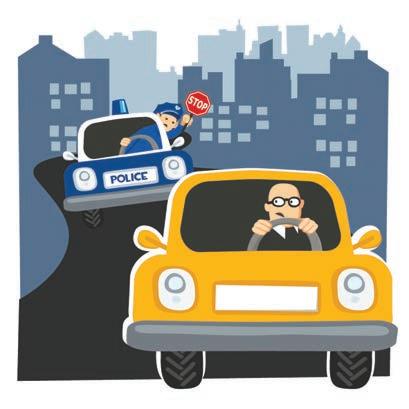
4 minute read
Traffic Stop: What to do if you are pulled over by police
By Andrea Iglar
One moment we’re driving along, and the next we notice blue and red flashing lights behind us.
Many of us have experienced being pulled over by a police officer—perhaps for driving over the speed limit, not quite stopping at a stop sign, or not realizing a tail light is burnt out.
While a traffic stop can be stressful, knowing what to do during a stop helps ensure the safety of motorists and officers.
The most important thing a driver should do is follow the police officer’s instructions, said John Phoennik, chief of the South Fayette Township Police Department.
“Listen to what the officer says and comply with the officer’s directions,” he said.

Illustration courtesy of Everycarlisted.com
South Fayette police Lieutenant John Leininger said he expects drivers to safely pull off the road, put the car in park, roll down the window and keep hands on the wheel.
“It shows you’re prepared to engage and speak with us,” he said.
Pennsylvania State Police Trooper Brent Miller said the officer’s priority during a traffic stop is the safety of everyone involved.
“First things first, don’t panic,” Trooper Miller said in a Twitter video. “Pull over as soon as you can, or if you’re unable to do so, slow down and put your four-way flashers on, acknowledging the officer’s presence.
“Once pulled over, turn on your dome light in your car and place your hands on top of the steering wheel and wait for the officer’s instructions.”
According to the state police, here are guidelines drivers should follow if pulled over by police:
--Stay calm, activate your turn signal and pull off the roadway as soon as possible.
--If it’s nighttime, turn on your interior lights to help the officer see inside your vehicle.
--Turn off the ignition and radio, and keep your hands on the steering wheel.
--Stay in your vehicle unless directed by the officer to exit. If asked to exit, stay safely away from traffic and keep your hands in plain view.
--Ask your passengers to remain calm and stay in the vehicle, while keeping their hands in plain view.

South Fayette Township police officer Christian Ryan exits his vehicle as part of a traffic stop demonstration.
Photo by Andrea Iglar
--Follow all instructions the officer gives you and your passengers.
--Give the police officer your full attention. The officer usually explains why they stopped you and may ask questions about your trip.
--Do not make sudden moves or search for your driver’s license, registration or insurance card until the officer asks for them. If the documents aren’t handy, tell the officer where they are before reaching for them.
--If you have a weapon in the vehicle, inform the officer immediately.
--If you are uncertain about the identity of an officer who is not in uniform or is driving an unmarked vehicle, you may ask for identification or call 9-1-1.
The police officer typically explains whatever action they are taking, such as issuing a warning or a traffic ticket with a fine. If you have questions, politely ask for clarification.
If you disagree with the officer’s decision to issue a traffic ticket, don’t prolong the contact by arguing with the officer. If you wish to dispute the ticket, you can do so in court.
Your acceptance of a traffic ticket is not an admission of guilt; however, refusal to sign a traffic ticket may result in your arrest.
If you believe an officer has acted inappropriately, document the officer’s behavior and report it to the police department in a timely manner. The name of the officer and law enforcement agency will be on the ticket, or you may ask the officer to provide this information.
“Being stopped by a law enforcement officer can be a stressful experience, but knowing what to do during the stop will help ensure your safety,” the state police said.
“Good communication from all involved parties can make a traffic stop a safe experience.”
For more information about traffic safety, visit @PAStatePolice or follow #AskTrooperBrent on Facebook and Twitter.
Find the brochure “What to Do When Stopped by the Police” at southfayettepa.com/policestops.

South Fayette Township police officer James Jeffrey, demonstrating the role of driver, hands his insurance and registration documents out the car window, while keeping his other hand visible.
Photo by Andrea Iglar
Police complete ‘implicit bias’ training
In August, all officers of the South Fayette Township Police Department completed online training called “Implicit Bias: Understanding the Impact on Actions and Decisions.”
The three-hour course, led by the public safety training company Calibre Press, aimed to improve communication skills and examine unconscious biases.
Topics included how to avoid racial and cultural bias that could cause an officer to view certain people as inherently dangerous—resulting in inaccurate assessments, flawed decisions and unnecessary use of force.
—Andrea Iglar
South Fayette police help raise money for cancer prevention, awareness





